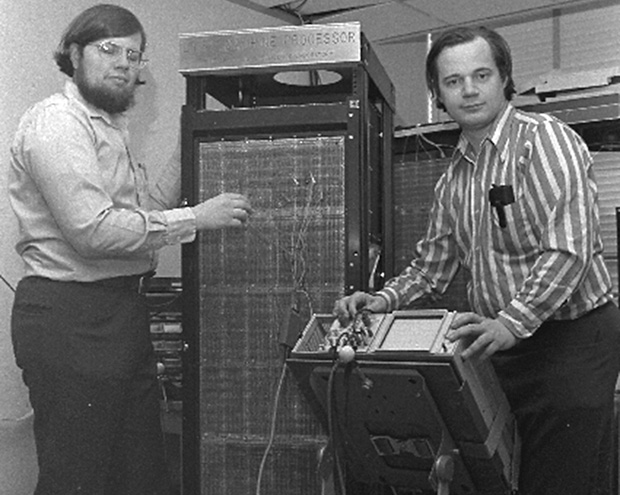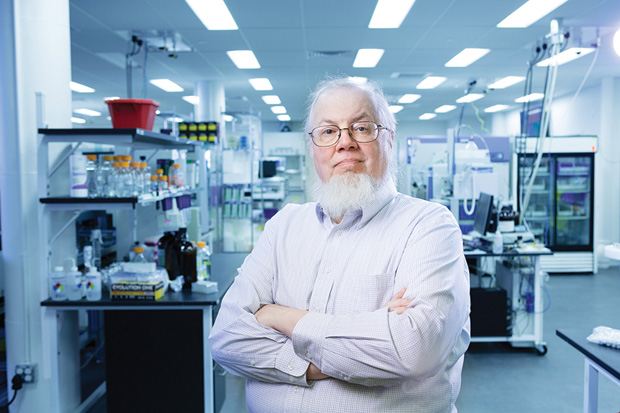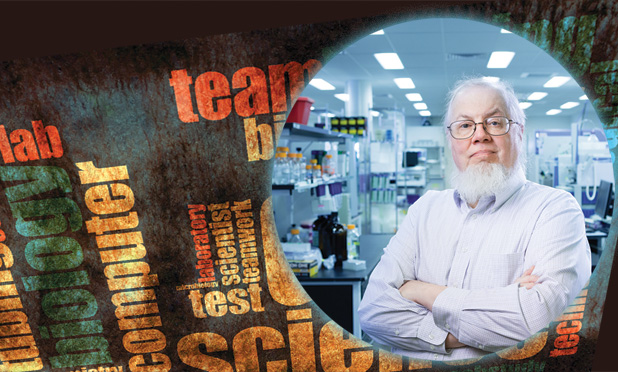Tom Knight may laugh when someone calls him the “godfather of synthetic biology,” but his ideas have helped spur a worldwide movement to look at biology with an engineer’s eye.
Knight’s road to synthetic biology was not a straight shot. As an adolescent, he took an interest in general science, inspired by researchers’ enthusiastic descriptions of their work in the pages of Scientific American. By the time he started high school, Knight was convinced he would become an organic chemist. But then the teenager took a course at a nearby college. The course was designed to teach high school students the programming language FORTRAN II. The college happened to be the Massachusetts Institute of Technology (MIT), and the then 15-year-old Knight snagged a summer position working for Marvin Minsky, who headed up the MIT Artificial Intelligence Laboratory. By the time Knight was ready for college, he was completely hooked on computer science. “Here was an emerging technology that very few other people had been involved with in a deep way, and one where I could get in the middle of it and do things that no one else had ever done,” he says.
He eventually enrolled at MIT and later joined its faculty. There, he became involved in a variety of major computing advances, including coengineering some of the fundamental interfaces of the Advanced Research Projects Agency Network (ARPANET), which is considered the precursor of the Internet; designing processors that were the basis for computer development in the 1970s and into the 1980s; and collaborating on a network that was incorporated into the Ethernet. In the late 1990s, his ideas became the foundation for the field of synthetic biology, and in 2008 he cofounded the Boston-based synthetic biology company Ginkgo Bio-Works.

IEEE Pulse caught up with Knight to ask him why he veered from computer science into biology and how he views the evolution of this new field of synthetic biology.
IEEE Pulse: You had made a name for yourself in computer engineering and were involved in some remarkable projects. When and why did you become interested in biology?
Knight: Other than a high school biology course that was along the lines of memorizing the names of the parts of flowers, I didn’t really have any experience in biology until I came back to it in a pretty serious way in the late 1980s. At that point, I was casting about, looking for the next interesting and challenging computer architecture to work on, because when you’re a computer architect, you are always seeking computational problems that have not been solved.
At the same time, I was teaching the graduate course at MIT in integrated circuit design. One of the things we teach very early in that course is the whole idea of Moore’s law (overall processing power will double every two years) and what happens when you shrink the size of transistors. The short version is that even back then, in 1990 or so, we could see that when you reached somewhere at the 10-nm scale—which is sort of where we are right now with the most advanced processes—things stopped working. And one of the reasons for that is you essentially run out of atoms: that is, the discreteness of the silicon lattice actually starts emerging as a major problem.
When I started thinking about that, it was clear the major difficulty is that fabrication technologies include lithography, etching, and ion implantation, which are all physical processes. That means the way in which they are putting atoms in the correct place is inherently statistical: you don’t always get the exact placement of atoms. If you think about it, chemistry is the science that puts atoms in the place you want them, and does that in a precise and controlled way; and the most sophisticated and the most effective chemistry is biochemistry. With biochemistry, I can design the sequence of a protein and, if I’m good at it, I can have a pretty good guess about the way in which that protein will fold up into a three-dimensional structure where every atom is defined in terms of its position. That’s a huge difference from the statistical sort of placement of atoms that physics gives us.
IEEE Pulse: That sounds like the story of nanotechnology.
Knight: It is, but it’s the nanotechnology story with a little bit of a shift in the sense that biology is the nanotechnology that works. We have a whole set of people who are attempting to build things at the nanoscale, and most of that work is being done with tools that are not very good. The good tools are the biological tools, and if you want to be a nanotechnologist and you want to be at the forefront of putting atoms where you want them to be, that leads you squarely to studying biology.
We needed to create a rational, predictive, engineering-based approach to understanding how to control living things, how to build them, and how to use them as the basis of the next generation of technology. That’s what led me to studying biology in a serious way in the early 1990s and to the creation of synthetic biology as a discipline in the late 1990s.
IEEE Pulse: What initially pushed the synthetic biology field forward?
Knight: I have to give full marks to the program managers at the Defense Advanced Research Projects Agency (DARPA) for providing me with the opportunity to go to the next step. DARPA sponsors a program during the summer in which they bring together collections of people to think about interesting research areas that should potentially be funded, and in 1996 I proposed to lead a study on the subject of what, at the time, I called cellular computing, which was the idea that you could embed computation inside of living cells and use that as a means of doing interesting things from a technological standpoint. DARPA funded it, and that allowed me to put together a microbiology lab inside the computer science department at MIT.
IEEE Pulse: How did the addition of a microbiology lab go over with your fellow faculty?
Knight: My colleagues were palpably nervous about all of this biology stuff and their health! As far as I know, however, I never even made anybody sick. So, I declare success in that sense.
IEEE Pulse: What happened next?
Knight: In honesty, the next three or four years were very educational for me but certainly didn’t produce anything of great import. I guess it was my postdoctoral experience, if you will. One of the things that I did learn during that time, though, was that, wow, there is no consistency in terms of how the biological community does experiments. As an engineer, I learned early on how to solder things together. There’s basically one way to do it: you get out your soldering iron and the solder, put the wires together with the solder, and heat it up. It wasn’t like that in biology. In biology, every experiment turned into two experiments. One was the experiment I wanted to do, and another was the experiment involved in building the pieces of DNA to do the first experiment. Not only that, but there were 30 different ways of building the pieces of DNA, and everyone seemed to have a different way of going about it. It was incredibly frustrating. That’s when I decided that someone needed to sit down and create a standardized process of putting together different pieces of DNA using a very consistent, straightforward, and easily understood mechanism. That’s classic engineering.
IEEE Pulse: And that led to your development of Biobricks (see “Let the Games Begin! 5,000-Strong iGEM Competition Builds the Synthetic Biology Field” on page 6 of this issue), which are well-characterized DNA snippets that code for discrete biological functions and became the basis for the Registry of Standardized Parts that you developed in collaboration with the International Genetically Engineered Machine Competition (iGEM).
Knight: Yes.
IEEE Pulse: What was the impact of this notion of standardization?
Knight: In my opinion, the major impact was that all of a sudden people started to talk about biology as an engineering discipline, and that really is a game changer.
There’s a natural tension between science and engineering that I think is not well understood by the world, and it was not well understood by me, actually, until I started interacting closely with the biologists. That natural tension mostly surrounds the issues of complexity. In general, the biology community views its job as studying nature in its natural complexity, so it’s sort of cheating if you take things apart and make things simpler, because that isn’t what that system looks like in its natural state. Engineers, on the other hand, don’t necessarily care what that system looked like in the natural world. Engineers want to perturb that system so it does what they want it to do. Those are two very different intellectual pursuits, and they lead to very different methodologies for studying things and for thinking about things.
So, really, synthetic biology is the engineer’s take on biology: how can we take these biological systems and use them in the applications that we care about? In fact, there’s a groundswell to rename the field “engineering biology.”

IEEE Pulse: How far can this new field—this engineer’s take on biology—take us in the next decade or so?
Knight: There’s a huge space of potential applications. I don’t think much will change in five years, but in ten years, hold onto your hats! There are going to be amazing things happening!
The difficulty lies in predicting what those changes are going to be. The way I like to explain this to people is to recall the first transistors back in the early 1950s and the first integrated circuits in the early 1960s. If you asked someone (from that era) to predict the development of cell phones or Facebook, I know damn well that they would not have been able to do it. It was still, however, perfectly obvious that it was going to be a central technology driver for the next century. I think we’re in a very similar situation with synthetic biology. I can’t say specifically what will get done with this technology, but what I can tell you is that this will be one of the most important technologies over the next ten or 20 years. It is going to be the technology that allows us to solve many of the food problems in the world, to increase the availability of water, to clean up pollution, to solve some of the energy crises that we have, and to terraform Mars. These are all things that you can see coming already.
If you look closer to home toward electronics, synthetic biology will have a major impact there. You’re already seeing people assembling molecular-scale electronics. There’s a group at IBM, for instance, that’s assembling carbon nanotube structures using pieces of DNA.
So while I can’t tell you the details of how those things will happen, what the specific impacts of synthetic biology will be, or which will be the most important, what I can tell you is that the impacts will be profound and revolutionary.



